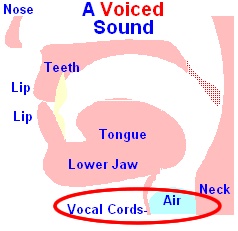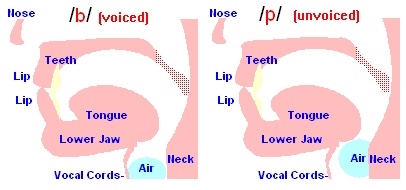Lesson 6
How to say it - /p/ & /b/ sounds
Introduction to Consonants
Some consonants are spelt with the same letters as the symbols for the sounds; eg. /p/ = 'p' and /b/ = 'b'. This is not always true for consonants; eg. 'j' = /ʤ/, 'y' = /j/ and 'ch' = /ʧ/. Consonants are either voiced or unvoiced.
The difference between an unvoiced sound and a voiced sound is that an unvoiced sound just uses air in the mouth, and a voiced sound uses air from the lungs. The air passes over the vocal cords in the neck, making them vibrate, so the sound is louder.

It is very difficult to hear the difference between voiced and unvoiced sounds; eg. /p/ and /b/, if the following sound is a vowel or a diphthong; eg. In "top of the hill", the 'p' sounds like a /b/.
This is because the voiced vowel or diphthong makes the previous sound voiced as well so that the sound is easier to say. However, it is more difficult to understand.
You have to guess what the word is from the other information. This is what English speakers do. They do NOT say every word exactly and they do NOT need to listen to every sound. They can guess what the word will be in about 0.2 second by listening to the first sound.
Introduction to /p/ & /b/
These consonants are spelt with the same letters as the symbols for the sounds, so /p/ = 'p' and /b/ = 'b'.
To make these sounds, close your lips tightly, push air against the inside of your lips, then quickly open your lips and mouth. The difference between /p/ and /b/ is that /p/ is an unvoiced sound, and /b/ is a voiced sound.
In /b/ the air touches the vocal cords and makes them vibrate. In /p/ the air does not vibrate the vocal cords.

Video of Mouth
Follow the instructions as they appear in the video.